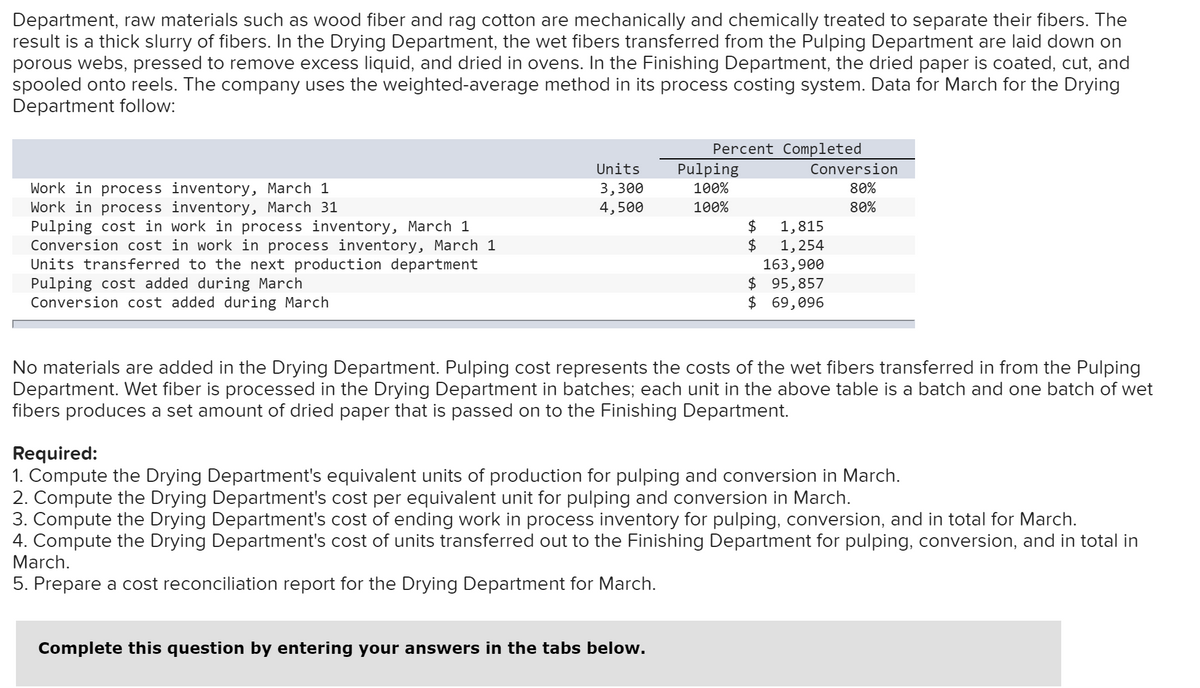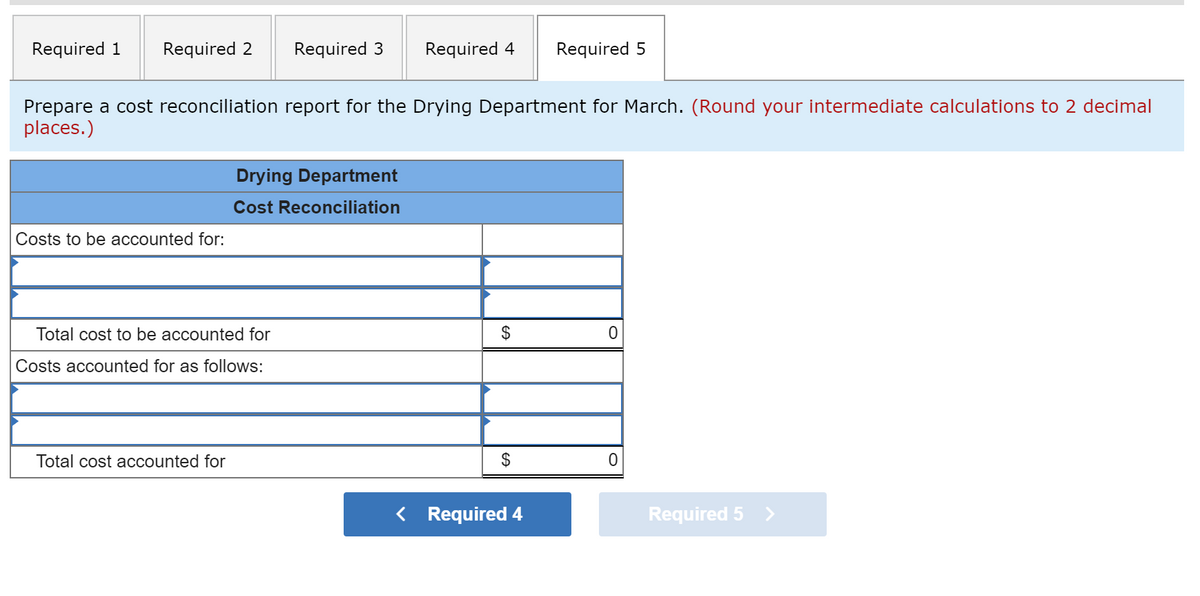Department, raw materials such as wood fiber and rag cotton are mechanically and chemically treated to separate their fibers. The result is a thick slurry of fibers. In the Drying Department, the wet fibers transferred from the Pulping Department are laid down on porous webs, pressed to remove excess liquid, and dried in ovens. In the Finishing Department, the dried paper is coated, cut, and spooled onto reels. The company uses the weighted-average method in its process costing system. Data for March for the Drying Department follow: Percent Completed Pulping Units Conversion 3,300 4,500 Work in process inventory, March 1 Work in process inventory, March 31 Pulping cost in work in process inventory, March 1 Conversion cost in work in process inventory, March 1 Units transferred to the next production department Pulping cost added during March Conversion cost added during March 100% 80% 100% 80% 2$ 1,815 2$ 1,254 163,900 $ 95,857 $ 69,096 No materials are added in the Drying Department. Pulping cost represents the costs of the wet fibers transferred in from the Pulping Department. Wet fiber is processed in the Drying Department in batches; each unit in the above table is a batch and one batch of wet fibers produces a set amount of dried paper that is passed on to the Finishing Department. Required: 1. Compute the Drying Department's equivalent units of production for pulping and conversion in March. 2. Compute the Drying Department's cost per equivalent unit for pulping and conversion in March. 3. Compute the Drying Department's cost of ending work in process inventory for pulping, conversion, and in total for March. 4. Compute the Drying Department's cost of units transferred out to the Finishing Department for pulping, conversion, and in total in March. 5. Prepare a cost reconciliation report for the Drying Department for March.
Department, raw materials such as wood fiber and rag cotton are mechanically and chemically treated to separate their fibers. The result is a thick slurry of fibers. In the Drying Department, the wet fibers transferred from the Pulping Department are laid down on porous webs, pressed to remove excess liquid, and dried in ovens. In the Finishing Department, the dried paper is coated, cut, and spooled onto reels. The company uses the weighted-average method in its process costing system. Data for March for the Drying Department follow: Percent Completed Pulping Units Conversion 3,300 4,500 Work in process inventory, March 1 Work in process inventory, March 31 Pulping cost in work in process inventory, March 1 Conversion cost in work in process inventory, March 1 Units transferred to the next production department Pulping cost added during March Conversion cost added during March 100% 80% 100% 80% 2$ 1,815 2$ 1,254 163,900 $ 95,857 $ 69,096 No materials are added in the Drying Department. Pulping cost represents the costs of the wet fibers transferred in from the Pulping Department. Wet fiber is processed in the Drying Department in batches; each unit in the above table is a batch and one batch of wet fibers produces a set amount of dried paper that is passed on to the Finishing Department. Required: 1. Compute the Drying Department's equivalent units of production for pulping and conversion in March. 2. Compute the Drying Department's cost per equivalent unit for pulping and conversion in March. 3. Compute the Drying Department's cost of ending work in process inventory for pulping, conversion, and in total for March. 4. Compute the Drying Department's cost of units transferred out to the Finishing Department for pulping, conversion, and in total in March. 5. Prepare a cost reconciliation report for the Drying Department for March.
Managerial Accounting
15th Edition
ISBN:9781337912020
Author:Carl Warren, Ph.d. Cma William B. Tayler
Publisher:Carl Warren, Ph.d. Cma William B. Tayler
Chapter3: Process Cost Systems
Section: Chapter Questions
Problem 1CMA: During December, Krause Chemical Company had the following selected data concerning the manufacture...
Related questions
Question
100%
1. Compute the Drying Department's equivalent units of production for pulping and conversion in March.
|
2. Compute the Drying Department's cost per equivalent unit for pulping and conversion in March. (Round your answers to 2 decimal places.)
|
3. Compute the Drying Department's cost of ending work in process inventory for pulping, conversion, and in total for March. (Round your intermediate calculations to 2 decimal places.)
|
4. Compute the Drying Department's cost of units transferred out to the Finishing Department for pulping, conversion, and in total in March. (Round your intermediate calculations to 2 decimal places.)
|
5. Prepare a cost reconciliation report for the Drying Department for March. (Round your intermediate calculations to 2 decimal places.)
FORMAT FOR 5 IN ATTACHED IMAGE

Transcribed Image Text:Department, raw materials such as wood fiber and rag cotton are mechanically and chemically treated to separate their fibers. The
result is a thick slurry of fibers.
porous webs, pressed to remove excess liquid, and dried in ovens. In the Finishing Department, the dried paper is coated, cut, and
spooled onto reels. The company uses the weighted-average method in its process costing system. Data for March for the Drying
Department follow:
the Drying Department, the wet fibers transferred from the Pulping Department are laid down on
Percent Completed
Pulping
Units
Conversion
Work in process inventory, March 1
Work in process inventory, March 31
Pulping cost in work in process inventory, March 1
Conversion cost in work in process inventory, March 1
Units transferred to the next production department
Pulping cost added during March
Conversion cost added during March
3,300
4,500
100%
80%
100%
80%
$
1,815
$
1,254
163,900
$ 95,857
$ 69,096
No materials are added in the Drying Department. Pulping cost represents the costs of the wet fibers transferred in from the Pulping
Department. Wet fiber is processed in the Drying Department in batches; each unit in the above table is a batch and one batch of wet
fibers produces a set amount of dried paper that is passed on to the Finishing Department.
Required:
1. Compute the Drying Department's equivalent units of production for pulping and conversion in March.
2. Compute the Drying Department's cost per equivalent unit for pulping and conversion in March.
3. Compute the Drying Department's cost of ending work in process inventory for pulping, conversion, and in total for March.
4. Compute the Drying Department's cost of units transferred out to the Finishing Department for pulping, conversion, and in total in
March.
5. Prepare a cost reconciliation report for the Drying Department for March.
Complete this question by entering your answers in the tabs below.

Transcribed Image Text:Required 1
Required 2
Required 3
Required 4
Required 5
Prepare a cost reconciliation report for the Drying Department for March. (Round your intermediate calculations to 2 decimal
places.)
Drying Department
Cost Reconciliation
Costs to be accounted for:
Total cost to be accounted for
$
Costs accounted for as follows:
Total cost accounted for
$
< Required 4
Required 5 >
Expert Solution
Step 1
1) Equivalent unit:

Trending now
This is a popular solution!
Step by step
Solved in 5 steps with 5 images

Knowledge Booster
Learn more about
Need a deep-dive on the concept behind this application? Look no further. Learn more about this topic, accounting and related others by exploring similar questions and additional content below.Recommended textbooks for you

Managerial Accounting
Accounting
ISBN:
9781337912020
Author:
Carl Warren, Ph.d. Cma William B. Tayler
Publisher:
South-Western College Pub

Cornerstones of Cost Management (Cornerstones Ser…
Accounting
ISBN:
9781305970663
Author:
Don R. Hansen, Maryanne M. Mowen
Publisher:
Cengage Learning

Managerial Accounting: The Cornerstone of Busines…
Accounting
ISBN:
9781337115773
Author:
Maryanne M. Mowen, Don R. Hansen, Dan L. Heitger
Publisher:
Cengage Learning

Managerial Accounting
Accounting
ISBN:
9781337912020
Author:
Carl Warren, Ph.d. Cma William B. Tayler
Publisher:
South-Western College Pub

Cornerstones of Cost Management (Cornerstones Ser…
Accounting
ISBN:
9781305970663
Author:
Don R. Hansen, Maryanne M. Mowen
Publisher:
Cengage Learning

Managerial Accounting: The Cornerstone of Busines…
Accounting
ISBN:
9781337115773
Author:
Maryanne M. Mowen, Don R. Hansen, Dan L. Heitger
Publisher:
Cengage Learning

Principles of Cost Accounting
Accounting
ISBN:
9781305087408
Author:
Edward J. Vanderbeck, Maria R. Mitchell
Publisher:
Cengage Learning

Excel Applications for Accounting Principles
Accounting
ISBN:
9781111581565
Author:
Gaylord N. Smith
Publisher:
Cengage Learning

Financial And Managerial Accounting
Accounting
ISBN:
9781337902663
Author:
WARREN, Carl S.
Publisher:
Cengage Learning,